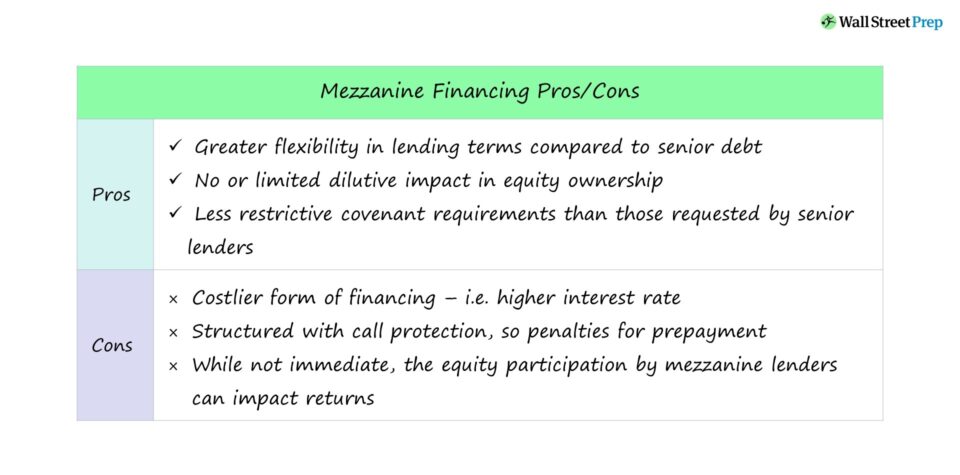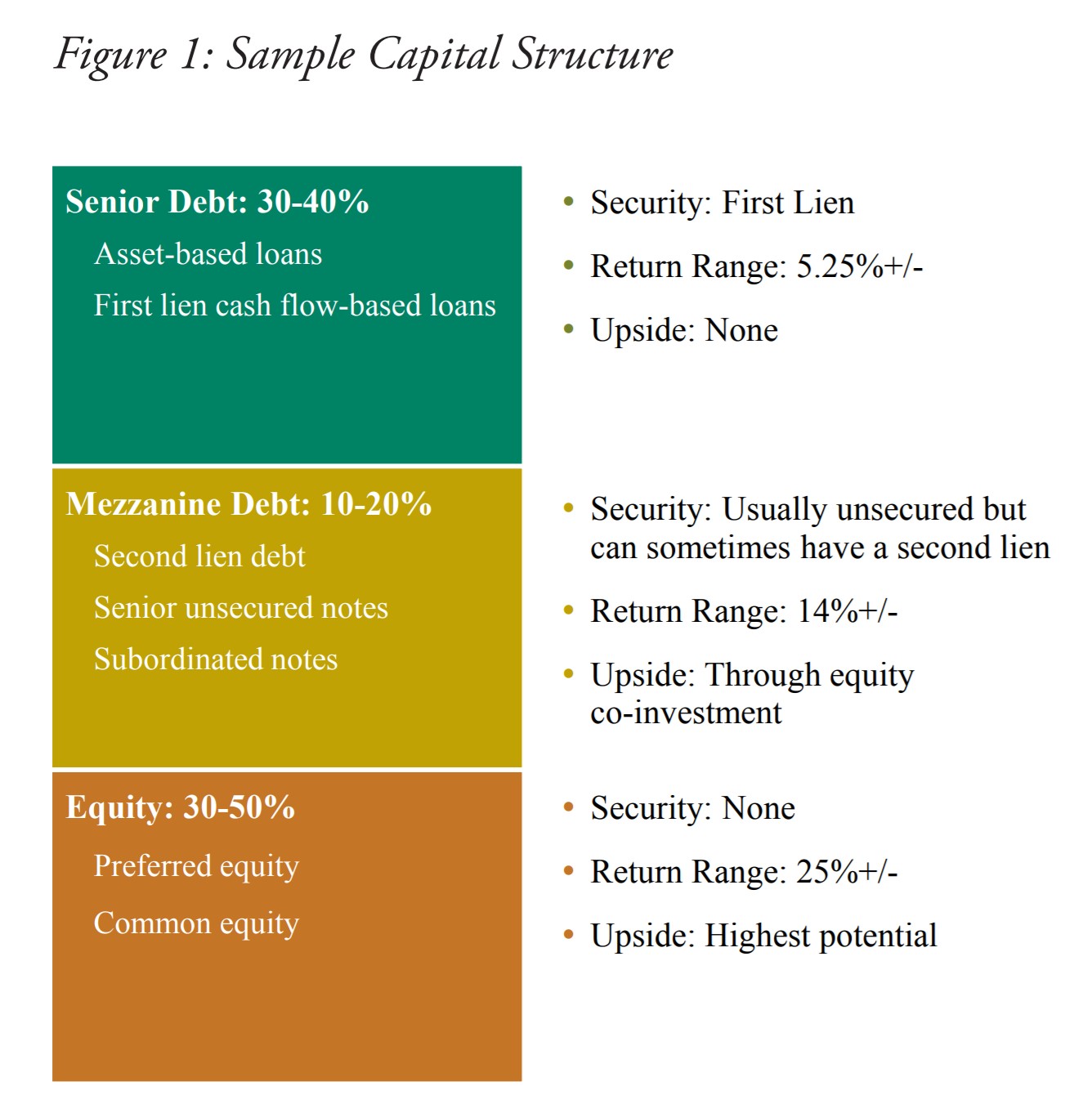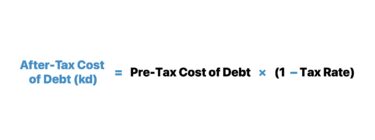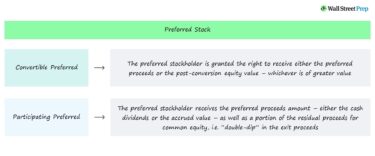What is Mezzanine Financing?
Mezzanine Financing is an alternative form of hybrid financing that blends features of debt and equity.
In practice, the most common examples of mezzanine financing include 2nd lien debt, senior or subordinated bonds, and preferred stock.

How Mezzanine Financing Works?
Within the capital structure, mezzanine financing is a junior form of debt that ranks below senior debt but sits above common equity.
However, while we’ve defined the formal definition of mezzanine financing, or “mezz financing” for short, the term typically refers to riskier forms of financing just above common stock – as opposed to all subordinated debt (i.e. lower priority than senior debt).
Mezzanine financing is NOT meant to be a long-term source of capital – instead, mezzanine financing is short-term funding for companies with a specific purpose (e.g. LBO financing, growth capital).
Some of the more common types of mezzanine financing instruments are the following:
- Convertible High-Yield Bonds (HYBs)
- Bonds or Preferred Stock w/ Warrants
- Convertible Preferred Stock
- Subordinated Notes with PIK Interest (“Paid-in-Kind”)
Oaktree Illustrative Capital Structure Example
The following illustration from Oaktree shows a sample capital structure of a company.
- Senior Debt (30-40%) → The top of the capital structure consists of senior secured debt, such as asset-backed loans and first lien cash flow based loans.
- Mezzanine Debt (10-20%) → Right in between senior debt and equity sits mezzanine debt, which blends features of debt and equity.
- Equity (30-50%) → At the bottom of the capital structure is common equity, which is last in line in terms of priority in the event of default.
As a general rule of thumb, the higher the security is placed on the capital structure, the less risk there is – further, less risk coincides with lower returns.
In contrast, the securities placed at the bottom of the capital structure possess the most risk, so the required rate of return is greater.

Sample Capital Structure (Source: Oaktree Mezzanine Strategy Primer)
What is the Structure of Mezzanine Financing?
Given the risk profile of mezzanine financing, the lenders – e.g. specialized mezzanine funds and hedge funds – require higher returns than senior lenders.
Contrary to a common misconception, lenders do NOT achieve their target return hurdle solely via higher interest rates.
In general, mezzanine lenders target a blended yield of around 15% to 20%+ and negotiate with borrowers to have two sources of returns:
- Interest Expense Payments – e.g. Cash Interest, PIK Interest
- Equity Participation – e.g. Warrants, “Equity Kickers,” Co-Invest Optionality
A so-called “equity kicker,” the opportunity to purchase the borrower’s equity, is intended to increase the potential returns to the lender, but the catch is that the feature is contingent on the underlying company performing well.
For example, warrants (i.e. the exercise of options that convert into common shares) provide the option to co-invest often at discounted prices with conversion features to participate in the upside of the equity.
Although more expensive than senior debt on a coupon pricing basis, mezzanine financing has more flexibility in its lending terms.
Mezzanine Financing: What are the Pros and Cons?
Benefits and Drawbacks to Borrower
Mezzanine financing is NOT permanent capital, but rather serves a specific purpose and will later be replaced by cheaper senior debt.
From the borrower’s perspective, who is likely undergoing an LBO or M&A-related activity, the reason for raising mezzanine financing is to raise more capital and meet the funding target.
Once a company has maximized its debt capacity for senior debt but needs to raise additional capital, the borrower is left with two options:
- Equity Financing: Issuances of more common stock, which further dilutes existing shareholders
- Mezzanine Financing: Negotiate debt with costlier but more flexible pricing terms
The objective for the borrower is to frequently minimize the amount of equity contribution required in the transaction, despite the costlier form of financing.
Management teams and existing shareholders, when raising capital, strive to minimize the amount of equity that must be “given up” through the negative effects of dilution.
Unlike senior debt, mezzanine financing ordinarily does not allow prepayment of debt ahead of schedule to sustain their returns (and charges expensive fees for doing so once the negotiated period has passed – i.e. call protection).
Benefits and Drawbacks to Lender
In exchange for undertaking the risk that senior lenders were unwilling to accept, mezzanine lenders expect higher returns and other monetary incentives.
Mezzanine financing is unsecured (i.e. no lien on asset collateral), so the chance of receiving full recovery proceeds in debt restructuring or liquidation is unlikely.
The primary drawback to the lender – the risk of potentially losing the original capital – is a substantial risk that requires extensive diligence into the borrower (and should be reflected in the extra compensation).
In effect, the mezzanine lender is aware of the risk associated with the financing yet is still willing to provide the capital as a calculated “bet” that the company can repay the obligation.
Additionally, it’d be uncommon to see mezzanine financing with mandatory amortization and/or with restrictive covenants, so more flexibility is given to the borrower.
What is the Role of Mezzanine Financing in LBOs and M&A Transactions?
Considering that mezzanine financing is a costlier form of debt, a fair question is: “Why is mezzanine financing used?”
The answer is related to the context of the financing, as mezzanine financing is often tied to acquisitions – leveraged buyouts (LBOs) in particular.
A borrower in raising a significant amount of debt first attempts to maximize the amount of “cheap” debt that can be raised from senior lenders.
Once a certain point is reached, risk-averse senior lenders like banks are no longer willing to provide capital.
In such instances, riskier types of debt financing are raised as a last resort to fill the remaining gap in capital required to execute the LBO transaction, which is why the most common purpose for mezzanine financing is funding LBOs.

Everything You Need To Master Financial Modeling
Enroll in The Premium Package: Learn Financial Statement Modeling, DCF, M&A, LBO and Comps. The same training program used at top investment banks.
Enroll Today





